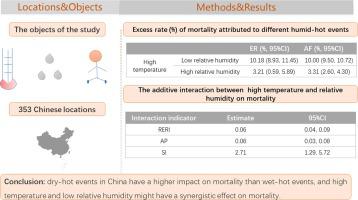Environment International ( IF 10.3 ) Pub Date : 2022-11-29 , DOI: 10.1016/j.envint.2022.107669 Wen Fang 1 , Zhixing Li 1 , Jinghua Gao 2 , Ruilin Meng 3 , Guanhao He 1 , Zhulin Hou 4 , Sui Zhu 1 , Maigeng Zhou 5 , Chunliang Zhou 6 , Yize Xiao 7 , Min Yu 8 , Biao Huang 4 , Xiaojun Xu 3 , Lifeng Lin 3 , Jianpeng Xiao 9 , Donghui Jin 6 , Mingfang Qin 7 , Peng Yin 5 , Yiqing Xu 6 , Jianxiong Hu 9 , Tao Liu 1 , Cunrui Huang 10 , Wenjun Ma 1

|
Background
Although many studies have reported the mortality effect of temperature, there were few studies on the mortality risk of humidity, let alone the joint effect of temperature and humidity. This study aimed to investigate the joint and interaction effect of high temperature and relative humidity on mortality in China, which will deepen understanding the health risk of mixture climate exposure.
Methods
The mortality and meteorological data were collected from 353 locations in China (2013–2017 in Jilin, Hunan, Guangdong and Yunnan provinces, 2009–2017 in Zhejiang province, and 2006–2011 in other Provinces). We defined location-specific daily mean temperature ≥ 75th percentile of distribution as high temperature, while minimum mortality relative humidity as the threshold of high relative humidity. A time-series model with a distributed lag non-linear model was first employed to estimate the location-specific associations between humid-hot events and mortality, then we conducted meta-analysis to pool the mortality effect of humid-hot events. Finally, an additive interaction model was used to examine the interactive effect between high temperature and relative humidity.
Results
The excess rate (ER) of non-accidental mortality attributed to dry-hot events was 10.18% (95% confidence interval (CI): 8.93%, 11.45%), which was higher than that of wet-hot events (ER = 3.21%, 95% CI: 0.59%, 5.89%). The attributable fraction (AF) of mortality attributed to dry-hot events was 10.00% (95% CI: 9.50%, 10.72%) with higher burden for females, older people, central China, cardiovascular diseases and urban city. While for wet-hot events, AF was much lower (3.31%, 95% CI: 2.60%, 4.30%). We also found that high temperature and low relative humidity had synergistic additive interaction on mortality risk.
Conclusion
Dry-hot events may have a higher risk of mortality than wet-hot events, and the joint effect of high temperature and low relative humidity may be greater than the sum of their individual effects.











































 京公网安备 11010802027423号
京公网安备 11010802027423号